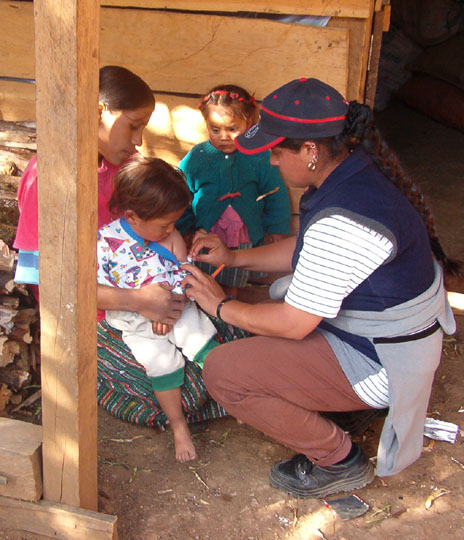Curamericas Fights to Improve Child Survival in Guatemala’s Triangle of Death
Posted: January 9, 2014
reposted from the mHealth Alliance
By Casey McCormick
Community-Based Impact-Oriented Child Survival in Huehuetenango, Guatemala
Curamericas Global has been working alongside our partner organization, Curamericas Guatemala, for over 10 years. In October of 2011, we launched a USAID-funded child survival program entitled “Community-Based Impact-Oriented Child Survival in Huehuetenango, Guatemala.” Our project aims to improve health and nutrition and ultimately reduce mortality among children under age five. Similarly, it targets women of reproductive age through community mobilization, capacity building, emergency response systems, and high-impact interventions. After intense formative research, we established objectives in maternal and newborn care, nutrition, pneumonia case management, control of diarrheal disease, and immunization.
Partnership with undeserved communities.

Our mission at Curamericas Global includes partnering with the most underserved communities, thus explaining this project’s target population, which resides in one of the most isolated, marginalized and high-mortality areas of Guatemala. The specific municipalities we work in are known as the “Triangle of Death” due to the high death rate for children under five years of age and mothers, as well as the harsh living conditions. According to the World Bank, as of 2011 the infant mortality rate in Guatemala was 24.2%, with rates in rural areas reaching 40%1. In Huehuetenango, for every 100,000 women, 181 die while giving birth2. At the onset of the program, only 10% of all births were attended by a skilled professional.
Increasing the number of births attended
In order to decrease infant and maternal mortality rates in Huehuetenango, we must increase the number of births attended by a skilled professional and improve access to emergency obstetric care. We believe one of the most effective ways to reach these goals is through utilizing mHealth. One component of our Community-Based Impact-Oriented (CBIO) approach is the development of emergency response systems. These systems link community members to the nearest health facility by a cell phone communication network and transportation plan.
mhealth: using technology to leverage success
Traditional birth attendants, known as Comadronas, and Care Group leaders trained in recognition of danger signs and referral protocols, are provided with a cell phone and receive phone minute allocations for urgent communication. Comadronas and Care Group leaders who encounter an emergency obstetric situation in their community are trained to immediately activate the community emergency response plan by informing the nearest health care facility and mobilizing transportation. As of 2009, the number of mobile phone subscribers in Guatemala had reached almost 16 million3. With an estimated total country population of 15 million4, there is indication of a high likelihood that project participants have access to a mobile device to contact their community’s Comadrona in times of emergencies, as well.
Proud partnership between Curamericas Global and Curamericas Guatemala
The utilization of these mHealth strategies led to a 15.7% increase in the number of women whose deliveries were attended by a trained health provider in the first year of the project’s implementation. Both Curamericas Global and Curamericas Guatemala are proud of the work being done in Huehuetenango. As we continue to learn more about mHealth and its benefits, we are excited to see this growing sector of public health take off and hope to incorporate it into future projects.
Looking for a way to help? Check us out!
Stay connected with Curamericas Global by visiting our website, Facebook page, YouTube, and join us! Our effort is to save lives of women and children in forgotten communities by fostering personable and sustainable health services. Take action Now
References:
1. Centro Nacional de Epidemiologia. Gobierno de Gautemala. “Memoria de Vigilancia”. 2008. http://epidemiologia.mspas.gob.gt/ Vigilancia de la mortalidad materina republica de Guatemala. 2012. http://epidemiologia.mspas.gob.gt/Eventos%20de%20Pagina/Mortalidad%20Materna.pdf
2. Centro Nacional de Epidemiologia. Ministeria de Salud Publica y A.S. “Vigilancia de la mortalidad materina republica de Guatemala.” 2013. http://epidemiologia.mspas.gob.gt/Eventos%20de%20Pagina/Mortalidad%20Materna.pdf
3. “Crecimiento de la telefonía fija y móvil en Guatemala.” Superintendencia de Telecomunicaciones. Guatemala City, Guatemala. http://www.sit.gob.gt/index.php?page=crecimiento-de-la-telefonia-fija-y-movil-en-guatemala
4. World Bank, World Development Indicators: Guatemala. 2011. http://data.worldbank.org/country/guatemala#cp_wdi%5C
– See more at: http://www.mhealthalliance.org/media-a-resources/members-news/171-curamericas#sthash.FPcYzxSv.dpuf
Share this Article
Stay Up-To-Date With Curamericas Global
We will not spam, sell or otherwise misuse your information!